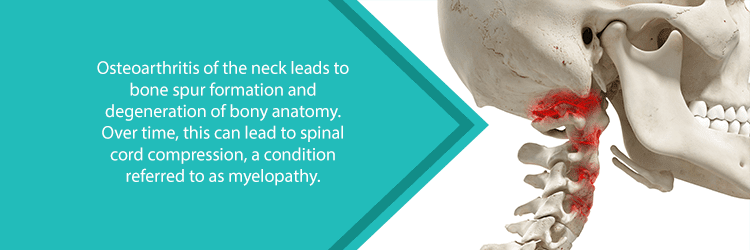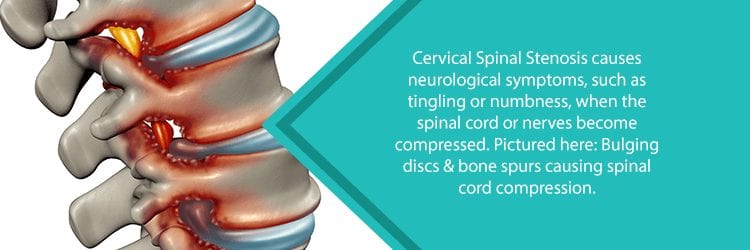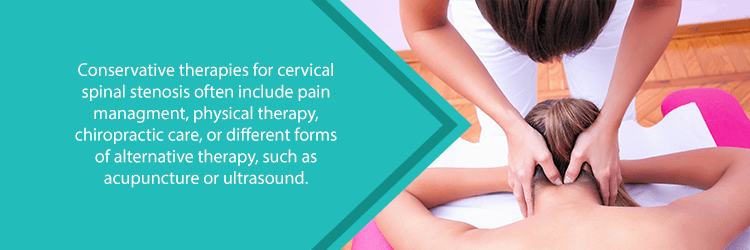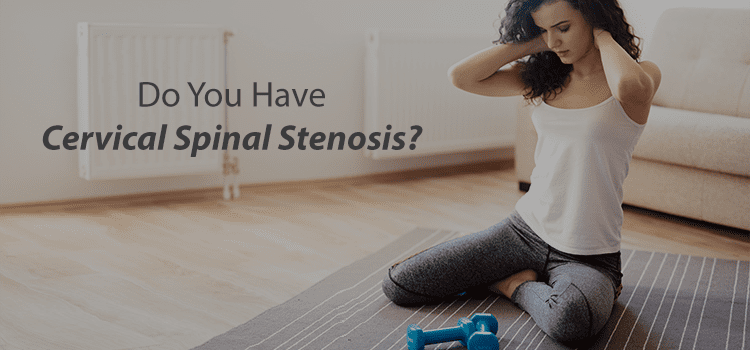Cervical spinal stenosis occurs when an abnormal event, such as a herniated disc, causes the spinal canal in the neck to narrow. Your spinal canal is a hollow tube that runs through each successive vertebra of your spine. More importantly, however, your spinal canal houses your spinal cord. If this small, 18-mm passageway becomes constricted to 13-mm or less, then deficits can occur. Namely, the spinal cord may suffer compression, a condition that doctors refer to as myelopathy.
Narrowing of the spinal canal (i.e. spinal stenosis) and spinal cord compression (i.e. myelopathy) can occur for a number of reasons. The top 3 causes include:
- Degenerative Disc Disease (DDD): DDD arises when our spinal discs begin to show signs of wear and tear. This can occur as a natural consequence of the aging process or as the result of an injury. As our intervertebral discs break down, they may suffer annular tears or distend beyond their normal perimeters, a condition known as a bulging disc. If a bulging disc places pressure on the spinal cord, then cervical stenosis with myelopathy can result.
- Cervical Herniated Discs: If a bulging disc ruptures, herniated disc material can become trapped (or “sequestered”) in the spinal canal. These tiny fragments of disc material can pinch, or even tear, the spinal cord.
- Osteoarthritis (OA) & Bone Spurs: OA occurs when the spine becomes inflamed from wear and tear, injury, or anatomical defects, setting a degenerative cascade of effects into motion. Cartilage breaks down. Ligaments harden. And, the facet joints can begin to develop bone spurs, or tiny outcroppings of bone tissue. Bone spurs cause symptoms, like neck pain, when the spinal cord or nerves become pinched.
Other causes of spinal stenosis include spondylolisthesis (i.e. a slipped vertebra), spinal cord injuries, and spinal tumors among others.

What are the Symptoms of Cervical Spinal Stenosis?
The onset of cervical stenosis often occurs very slowly, taking years for the full effects to creep in. As you’ll notice, the top 3 causes of cervical stenosis are degenerative (or related to the aging process). This often means that, excluding injuries, symptoms won’t set in overnight. However, it also means that symptoms can vary quite a bit in intensity–from barely perceptible to excruciating or limiting. Common signs of cervical spinal stenosis include:
- Radiating Pain: Cervical stenosis causes pain in the neck that can radiate down into the shoulders, arms, hands, or fingertips. Known as cervical radiculopathy, the pain may be described as searing, electric, or tingling.
- Arm & Hand Weakness: Because your cervical spine connects to nerves that control motor movements in the arms and hands, you may develop muscle weakness in these areas. You may also experience a loss of gross motor control (your ability to flex, extend or rotate your arms) or fine motor skills (intricate tasks like buttoning a shirt).
- Shoulder Weakness: In addition, the nerves in your neck supply sensation and motor information to the muscles in your shoulders. As such, the muscles that control your shoulder blades and deltoid muscle (the ball of muscle that wraps around your outer shoulder) can begin to waste away.
- Leg Weakness: Believe it or not, there are nerves in your neck that play a direct role in your ability to walk. Compression of these nerves roots causes pain in the legs, muscle weakness, balance issues, and painful contractions of the leg muscles.
- Neurological Issues: As with any form of nerve compression, you may develop neurological issues such as tingling or numbness in the arms and legs, loss of pain detection, and reduced touch sensation.

I think I have Cervical Spinal Stenosis… What Should I Do Next?
If you think that you might have cervical stenosis, then don’t hesitate to contact a board-certified spine surgeon or orthopedist. Although a majority of cervical stenosis cases can be treated without surgery, cervical stenosis is often a progressive condition that will worsen with time. The good news is that treatment can slow (or even halt) the progression of the problem.
To fully diagnose your condition, your doctor will need to perform a variety of tests. These tests may include nerve conduction studies, reflex tests, and skin sensation exams.
In addition, your doctor will likely prescribe imaging exams to determine the source of your spinal stenosis. X-rays can be used to detect bony obstructions in the spinal canal (like slipped discs or bone spurs); whereas, your doctor may prescribe an MRI to view soft tissues–like the spinal cord itself. Equipped with an accurate diagnosis of the problem, your doctor can suggest a course of minimally invasive or conservative treatments.
Conservative Therapies for Cervical Spinal Stenosis
Many patients with cervical stenosis find that nonsurgical treatments are sufficient to manage their neck pain. An initial course of treatment for cervical stenosis, for example, may include over-the-counter or prescription-strength medications. In addition, nerve pain medications (like Lyrica) or SSRIs (like Cymbalta) can be used to treat symptoms of neuropathy.
Aside from pain management, your doctor may also recommend physical therapy or chiropractic to help get you back on your feet. Physical therapy for spinal stenosis often involves exercises that help you preserve neck motion while building shoulder and neck muscle strength. In contrast, chiropractic care often entails using hands-on manipulation to adjust neck anatomy in a way that relieves pressure on the spinal cord.
For those who would like to try alternative forms of therapy for spinal stenosis, acupuncture, massage therapy, and yoga may help you find relief.

Surgical Treatments for Cervical Spinal Stenosis
Unfortunately, some patients with cervical spinal stenosis will not find relief with conservative methods. For these patients, surgery is often the answer. If you need cervical spinal stenosis surgery, your doctor may recommend:
- Laminectomy: During a laminectomy your surgeon will remove the lamina, or back side, of your vertebra. Because the lamina serves as sheathing for your spinal cord, removing it allows your spinal cord to decompress.
- Anterior Cervical Discectomy & Fusion (ACDF):During this procedure, your doctor will remove a damaged or herniated disc and replace it with an artificial model. After the disc has been extracted from the front (or anterior side), your surgeon will insert a bone graft into the interbody space. As this bone graft matures, the artificial disc will fuse to the adjacent vertebrae. This solution for cervical spinal stenosis provides more stability to the spine than a standard artificial disc replacement.
Do you need surgery for cervical spinal stenosis? To find out if you are a candidate, contact our board-certified cervical stenosis specialists at New Jersey Spine & Orthopedic! Our award-winning team specializes in minimally invasive interventions for spinal cord compression, including ACDF! For care that you can trust, contact our spine team today!

